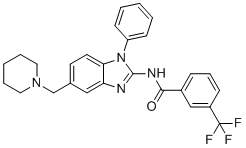
IRAK4-IN-16
CAS No. 509093-72-5
IRAK4-IN-16( IRAK4 inhibitor 16 )
Catalog No. M14747 CAS No. 509093-72-5
A potent, selective, and orally bioavailable inhibitor of interleukin-1 receptor-associate kinase-4 (IRAK4) with IC50 of 2.8 nM.
Purity : >98% (HPLC)
 COA
COA
 Datasheet
Datasheet
 HNMR
HNMR
 HPLC
HPLC
 MSDS
MSDS
 Handing Instructions
Handing Instructions
| Size | Price / USD | Stock | Quantity |
| 100MG | Get Quote | Get Quote |


|
| 200MG | Get Quote | Get Quote |


|
| 500MG | Get Quote | Get Quote |


|
| 1G | Get Quote | Get Quote |


|
Biological Information
-
Product NameIRAK4-IN-16
-
NoteResearch use only, not for human use.
-
Brief DescriptionA potent, selective, and orally bioavailable inhibitor of interleukin-1 receptor-associate kinase-4 (IRAK4) with IC50 of 2.8 nM.
-
DescriptionA potent, selective, and orally bioavailable inhibitor of interleukin-1 receptor-associate kinase-4 (IRAK4) with IC50 of 2.8 nM, 217- and 892-fold selectivity over IRAK-1 and TAK1, respectively; inhibits IL-1 induced activation of NF-kB in primary human monocytes with IC50 of 0.3 uM, possesses excellent selectivity and pharmacokinetic properties.
-
In Vitro——
-
In Vivo——
-
SynonymsIRAK4 inhibitor 16
-
PathwayImmunology/Inflammation
-
TargetIRAK
-
RecptorIRAK
-
Research Area——
-
Indication——
Chemical Information
-
CAS Number509093-72-5
-
Formula Weight478.519
-
Molecular FormulaC27H25F3N4O
-
Purity>98% (HPLC)
-
Solubility——
-
SMILESO=C(NC1=NC2=CC(CN3CCCCC3)=CC=C2N1C4=CC=CC=C4)C5=CC=CC(C(F)(F)F)=C5
-
Chemical NameN-(1-phenyl-5-(piperidin-1-ylmethyl)-1H-benzo[d]imidazol-2-yl)-3-(trifluoromethyl)benzamide
Shipping & Storage Information
-
Storage(-20℃)
-
ShippingWith Ice Pack
-
Stability≥ 2 years
Reference
1. Wang Z, et al. Bioorg Med Chem Lett. 2015 Dec 1;25(23):5546-50.
molnova catalog



related products
-
IRAK inhibitor 1
IRAK inhibitor 1 is a potent IRAK-4 inhibitor with IC50 of 216 nM.
-
IRAK inhibitor 2
IRAK inhibitor 2 is a potent IRAK inhibitor.
-
Thalidomide 4-fluori...
Thalidomide 4-fluoride (Cereblon ligand 4) is the Thalidomide-based Cereblon ligand. Thalidomide 4-fluoride can be used in the recruitment of CRBN protein.



 Cart
Cart
 sales@molnova.com
sales@molnova.com


